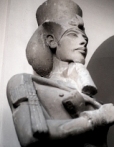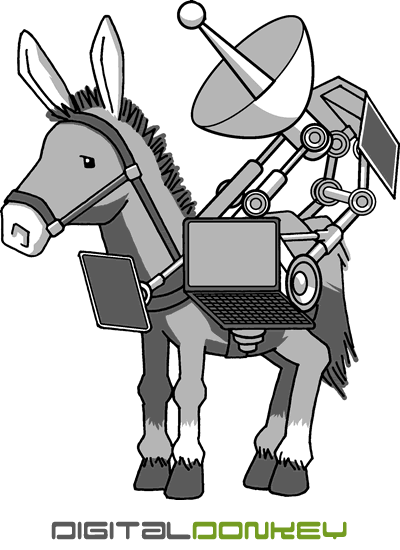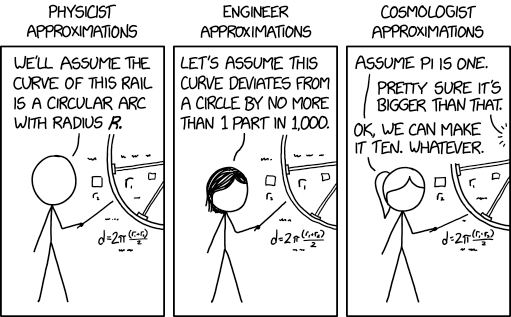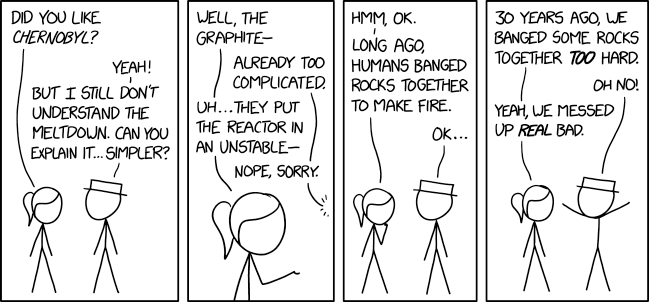As we usually do around this time of year, it's summer break season for TDWTF. This week, we're going to rerun some old classics, starting with this legend from 2006, compiled into a single article. --Remy
The Virtudyne saga (published 2006-Oct-10 through 2006-Oct-13) is my all time favorite. It tells the story of the rise and fall of Virtudyne, one of the largest privately-financed ($200M) disasters in our industry. Like most articles published here, all names have been changed to protect the guilty, and I've worked very closely with Rob Graves (the submitter) to ensure that this presentation is as close to how it happened as possible.
Part I - The Founding
 By most people's standard, The Founder was very wealthy. A successful entrepreneur since age seventeen, he built several multi-million dollar companies and amassed a fortune larger than that of most A-list Hollywood celebrities. He prided himself on having one of the largest private collections of Egyptian artifacts in the world and prominently displayed many of them in his Great Room. And it truly was a great room: having been to The Founder's mansion several times, Rob recalls that his two-story, four-bedroom home could easily fit inside the Great Room.
By most people's standard, The Founder was very wealthy. A successful entrepreneur since age seventeen, he built several multi-million dollar companies and amassed a fortune larger than that of most A-list Hollywood celebrities. He prided himself on having one of the largest private collections of Egyptian artifacts in the world and prominently displayed many of them in his Great Room. And it truly was a great room: having been to The Founder's mansion several times, Rob recalls that his two-story, four-bedroom home could easily fit inside the Great Room.
The Founder was at home one day, doing whatever retired rich people did in 1999, and became extremely aggravated with how slow his brand-new, top-of-the-line computer was running. While cursing Microsoft Office, he had an "ah-ha" moment: he could build a better Microsoft Office.
Recalling his days as a Digital PDP-11 programmer, he knew that he could write financial software that would support fifty users, perform great, and run in 256-bytes of memory. Given the monumental advances in the twenty-years since he coded, he was elated just to think what would be possible with a bunch of top-notch programmers such as himself. He wondered just how many people it would take to build a Microsoft Office killer.
 One thing led to another and Virtudyne was born. Its goal was modest: become the next Microsoft Office killer. The Founder hired his long-time colleague as the Chief Information Officer and together, they would create The Plan. It was simple: develop an internet/intranet based Office/Collaboration system that would deliver "90% of functionality that 90% of [Microsoft Office] users use."
One thing led to another and Virtudyne was born. Its goal was modest: become the next Microsoft Office killer. The Founder hired his long-time colleague as the Chief Information Officer and together, they would create The Plan. It was simple: develop an internet/intranet based Office/Collaboration system that would deliver "90% of functionality that 90% of [Microsoft Office] users use."
An avid programmer himself, the CIO knew exactly how they could accomplish this. He convinced The Founder that, with a handful of programmers helping him, he could develop a client/server Microsoft Office Killer using Visual Basic 6. And with the latest hardware available, their application could easily scale to support twenty million users using one, maybe two servers. And best of all, it would all take only six months to create.
It was the perfect opportunity to jump on the .com bandwagon. They just could feel the IPO beckoning them. The Founder invested a few million of his own dollars and the CIO started hiring.
One of the first people the CIO approached was Rob Graves. He wanted Rob to become the database administrator, telling him only that Virtudyne was a pre-IPO startup bankrolled by The Founder. As tempting as it was, Rob had a second kid on the way and declined the offer. The CIO would have to find another DBA for the project.
What better place to find a DBA than the same place he turned for the rest of the initial hiring: the local Visual Basic special interest group. In fact, not only did he find a DBA at the SIG, he found one that proclaimed to be one of the greatest DBA in the world. And not because he possessed extensive database administration skills, but because he was willing to admit to The Truth: with the GUI-tools and automagic processes that modern databases offer, all those extensive database administration skills are meaningless.
Sadly, the DBA was one of the more talented members of the initial Virtudyne team.
Part II - The Gathering
The Founder had little trouble convincing his millionaire friends to invest in Virtudyne. It wasn't so much the idea of a Microsoft Office Killer, but that fact that it was 1999 and just about anyone with an internet company could go public and become an overnight billionaire. Within one month of The Founder's grandiose idea, he had secured an impressive eleven million in funding.
While The Founder solicited investors, the Chief Information Officer solicited employees. The CIO knew it would take "only a handful of strong programmers" to develop the Microsoft Office Killer and hired ten of the best programmers he could find. He promised a high salary, good stock options, and the chance to beat the market leader at their own game. Though his team's competence was minimal, their confidence was as strong as ever. They were all eager to build the Microsoft Office Killer.
 It was the opportunity of a lifetime handed to the CIO on a silver platter: millions in capital and a dedicated team of developers. It was up to him to get busy with a clear vision, detailed requirements, a throughout market analysis, an extensive design, and solid architecture. Instead, he discovered something much more important: Magic: The Gathering.
It was the opportunity of a lifetime handed to the CIO on a silver platter: millions in capital and a dedicated team of developers. It was up to him to get busy with a clear vision, detailed requirements, a throughout market analysis, an extensive design, and solid architecture. Instead, he discovered something much more important: Magic: The Gathering.
The CIO dedicated his "lunch break" to his Magic card collection. This, of course, meant that he'd spend much of his day thinking up new deck concepts, building them, and testing them out. He even got some of his developers hooked: they'd all get together during their "lunch break" and play, trade, and chat about the latest happenings in the world of Magic: The Gathering.
Don't get me wrong, Magic wasn't the Chief Information Officer's only focus. With his new job title, he was eligible to receive executive-level trade publications for free. In fact, one of his first acts as CIO was to purchase a top-of-the-line solid ink printer. In addition to producing sharp full-color graphs for presentation packets, it printed up some wicked high-quality "proxy cards" for everyone's Magic decks.
Days turned into weeks, weeks turned into months, and next thing they knew, six months had passed and not a single line of code had been written. What made this especially bad was the fact that the investors were flying in to town to check on everyone's progress. They were all eager to see just how their Microsoft Office Killer was coming along.
Thank goodness that the Chief Information Officer chose Visual Basic 6 as their platform. Real magic ensued when the following were combined: a handful of developers, a caffeine-filled all-nighter, and VB6's wonderful ability to drag & drop controls onto Windows form and "hard code" what shows in the labels, text boxes, drop downs, etc.
 The investors were not impressed. They were astonished. In fact, the demonstration convinced them that, not only the project was on track, but that Virtudyne was poised to take on Microsoft and its ubiquitous office suite. Word spread fast and even more investors signed up. Tens of millions of dollars started pouring into Virtudyne.
The investors were not impressed. They were astonished. In fact, the demonstration convinced them that, not only the project was on track, but that Virtudyne was poised to take on Microsoft and its ubiquitous office suite. Word spread fast and even more investors signed up. Tens of millions of dollars started pouring into Virtudyne.
The new investment might have been the CIO's motivation to finally get cracking on the project. Or it could have been the fact that the .com bubble was starting to burst and that meant they'd have to make a real attempt at making a product. He immediately started hiring again. And I mean hiring. A massive recruiting campaign was initiated and developers from all over the country were brought in. Within a year, the Virtudyne CIO commanded an army of I.T. professionals whose skill levels ranged between complete ineptitude and moderate competence.
The Chief Information Officer also purchased the best server he could find advertised in his executive trade publications: the Unisys ES7000. It was a thirty-two processor beast with sixty-four gigabytes of RAM and an attached EMC CLARiiON storage server. This $1.3M machine would be the single production server for their anticipated 20,000,000 users.
With all the new talent and the fancy new hardware, development of the Microsoft Office Killer finally began. The biggest hurdle that faced the developers was the new requirements. You see, one of the major selling points to investors was that Virtudyne's office suite already had every feature they asked for: it ran on Windows, Linux, and even Palm OS. All the developers had to do was make it actually do that.
Rob Graves joined Virtudyne around its second-year anniversary. He had been contacting part-time, off-and-on since day one, and they finally made him an offer he could not refuse: lead role in a company of 100+ developers, top-of-the-line development hardware, a dedicated QA team, and most of all, a $50,000 raise with five weeks paid vacation. No one could top that in the post .com-bubble.
In the year that followed, Rob found himself in the middle of quite a few political battles between the "do it right" and the "do it now" developers. Nothing too spectacular, especially in the context of this entire Virtudyne saga, but Rob did note who won the argument over whether or not to use the special coding techniques recommended by Unisys and Microsoft to utilize the server's full potential. I'll let you guess which side that was.
Despite all this, Virtudyne lacked one thing: customers. Allow me to clarify that because saying that they lacked "customers" might imply they had "a" customer. They didn't. The sales department of eight was unable to find a single organization willing to license their product.
This was especially problematic because their initial $94M war chest had dwindled to less than $10M. Investors were starting to wonder about their "six-months-to-develop Microsoft Office Killer" and stopped pouring money into Virtudyne. Something needed to be done.
Part III - The Savior Cometh
Virtudyne's first three years are best summed up with a single word: disastrous. Nearly $90M had been spent developing a product that was barley functional and completely unsalable. Most would call that "miserable failure" and encourage all involved to salvage what they could, abandon ship, scuttle the remains, and never look back. But one person saw it as the golden opportunity; he was known as The Savior
The Savior was a self-made billionaire who struck it rich doing the type of business that makes unregulated industries regulated. He heard about Virtudyne's struggles and wanted to help out. He contacted the powers that be and offered some very reasonable terms. In exchange for investing $100M, he would take over operations and sit as chairman on the board of directors. It seemed to be a a win-win for everyone.
Even the Virtudyne employees were excited. They welcomed their new overlord with open arms and truly believed that The Savior would turn the company around with his "new management team of highly-qualified executives with a proven track record." Such statements tend to be very convincing when accompanied with a hundred million dollar investment.
Unfortunately, employee confidence wore off almost immediately. It wasn't so much that the fact that the superstar executives consisted primarily of The Savior's immediate family, but more the fact that they managed to set the bar of incompetence even higher. I suspect that, given yesterday's article, this might seem impossible, so I'll share my favorite three people that The Savior brought in.
 First and foremost, there was the new chief of operations, heralded as a "brilliant innovator" and "technological wizard." He was also The Savior's eldest son. Junior's grasp on technology is best illustrated with this simple anecdote: one day, Junior was walking past Rob Graves' office and saw a graph actively moving around on the screen. He got incredibly exited and wanted to know how he could get the cool looking monitoring software Rob was using to watch their World Wide Server. Rob just didn't have the heart to tell him it was the "Bars and Waves" visulization from Windows Media Player.
First and foremost, there was the new chief of operations, heralded as a "brilliant innovator" and "technological wizard." He was also The Savior's eldest son. Junior's grasp on technology is best illustrated with this simple anecdote: one day, Junior was walking past Rob Graves' office and saw a graph actively moving around on the screen. He got incredibly exited and wanted to know how he could get the cool looking monitoring software Rob was using to watch their World Wide Server. Rob just didn't have the heart to tell him it was the "Bars and Waves" visulization from Windows Media Player.
One of Junior's first acts as operations chief was to partner up with a major hardware vendor peddling another completely unsalable product. It was a massively-parallel server that featured a proprietary operating system with an integrated database. The sales rep told them that "reliability, not speed, is our primary concern" and they meant it. The $350,000 development server had the same processing power as a 600MHz Pentium II that even a charity organization would refuse as a donation.
Perhaps Junior's logic was that anyone stupid enough to buy the hardware would be stupid enough to buy their Microsoft Office Killer. Unfortunately, Virtudyne seemed to hold a monopoly on the world's supply of stupidity. The expensive hardware and vast amount of effort to port the software resulted in only a single sale, and it was a sale for the hardware vendo to Virtudyner.
The next person on the list was known as The VP of Nothing. I don't that's a very fair title because he actually did two things. First and foremost, despite having no direct reports or job responsibilities, he collected a six-figure paycheck. And secondly, he was allowed to bypass the proxy filter to surf the web; it was no secret why. A curious network administrator looked in the logs and discovered that The VP of Nothing spent a lot of time looking at pictures of large Amazonian women wrestling with little men. Seriously.
My personal favorite that The Savior brought in was The Janitor. Now it may seem odd that the chairman of the board would insist upon changing cleaning companies, but it's even stranger what the new "cleaning company" consisted of: The Savior's youngest son. The Janitor was a trust-fund baby and wealthier than most of us will ever be. It became pretty apparent why he couldn't keep a job anywhere else: after a few months of his cleaning service, ants and cockroaches were everywhere, the VB team had a gnat infestation, and the restrooms became so dirty that most managers allowed their employees to go home if they needed to use the facilities.
Amazingly, this new team was able to find a paying customer. It was The City. Virtudyne's office suite was to be installed at all libraries and made available for download by city residents. All it took was some lobbying at city council, a few calls to the local media, and a sizable march on city hall with "unemployed" protestors demanding the city provide free office software. Although the majority of the protesters were Virtudyne employees, the city finally agreed and signed an $8,500,000 three-year contract, collectable upon timely delivery of the software specified in the contract.
The main problem (well, aside from the fact that Virtudyne's Office Killer was a joke compared to any office suite) was that the contract called for a product that would replace Microsoft Access. In fact, it was a major selling point: the sales VP gave a demo of a product that didn't exist.
It fell on Rob Graves and a handful of other developers to create an application in two weeks that would "allow users with no database and minimal computer knowledge to: build applications; add users and groups to access the application; set security at the form-, record-, and field- level;" and so on. Rob is embarrassed to report that they actually managed to deliver a completely useless application that met every word in the ambiguous requirements to technically fulfill the contract.
None of tha mattered, though. Employee morale was at an all time high and things were finally starting to look good. It only took three and half years and nearly $150M dollars, but they finally made eight and half million dollars. Unfortunately, the sale also brought something else to the Virtudyne: paranoia.
 Junior held a company-wide meeting to discuss a very serious issue: Microsoft was onto them. They were shaking in their boots and saw Virtudyne as a major threat. They would stop at nothing to get their grubby hands on the product and might even try to steal the source code. Of course, at that point, about half the people at Virtudyne realized that all one would have to do to "get their grubby hands" on their Microsoft Office Killer was to go into any of The City's public libraries and ask for an installation disk. Obviously, Junior wasn't in that half.
Junior held a company-wide meeting to discuss a very serious issue: Microsoft was onto them. They were shaking in their boots and saw Virtudyne as a major threat. They would stop at nothing to get their grubby hands on the product and might even try to steal the source code. Of course, at that point, about half the people at Virtudyne realized that all one would have to do to "get their grubby hands" on their Microsoft Office Killer was to go into any of The City's public libraries and ask for an installation disk. Obviously, Junior wasn't in that half.
Within days, Junior ordered cameras to cover every square inch of the Virtudyne facility. Fingerprint scanners were installed at every door, both inside and out, and full-time security guards were placed at key locations throughout the building. All exterior windows were covered with a translucent film to prevent Microsoft from peeping in and, just to be safe, computer monitors could no longer face outside windows. Key employees were issued with special pagers that allowed them to discretely press a button to alert the private investigator if they found themselves being followed by Microsoft's white vans.
The draconian security measures didn't help the recent boost in employee morale. In fact, over the next year, employee morale sunk to an all-time low, leading to a mass exodus from the company. Key employees were dropping like flies and all Junior would do to maintain headcount was to hire more employees.
Eventually, Junior struck a good balance between tight security and employee indifference and managed to stabilize the loss. Unfortunately, that didn't help business much. Almost two years had passed since the single sale to The City and Virtudyne couldn't even give away their product. It's hard to say whether it was the terrible product itself or the fact that the Virtydune's contract with The City sparked a state-wide scandal with accusations of impropriety going all around.
What Virtudyne needed was a new market. A market that hadn't heard of Virtudyne before. And preferably, one that wouldn't do any research before spending millions to license their product.
Part IV - The Digital Donkey
After three years of full-time employment at Virtudyne, Rob Graves finally decided to call it quits. Most of Rob's friends and family thought he was insane to leave a cushy job where he was making 30% more than he could anywhere else in town. But then again, most of his current and former coworkers thought he was insane for staying so long.
Virtudyne had blown through nearly $200,000,000 of investor capital over five years to develop their Microsoft Office Killer. All they had to show for it was a barely functional product with a small subset of Microsoft Office's features and a single $8.5M sale. And technically, they only collected $5.8M on the sale because their customer withdrew the contract.
The sales and marketing department were desperate for ideas. They literally couldn't give their software away; anyone with even the most basic knowledge of Google could find out how well Virtudyne's first customer worked out. No one wanted to be their second.
But just then, it dawned on the sales team. They needed to find a market where the Internet had not yet reached. In such a market, their office suite would develop interest and that interest would lead right in to sales. One of the executives knew exactly how to find and penetrate such a market. They would use The Digital Donkey.
The CEO was a bit skeptical at first, but eventually realized how great of an idea it was. It was the perfect plan to sell their product to a market that no one else has ever tapped before. He signed off on the project.
Virtudyne engineers were tasked with figuring out a way to attach a satellite dish, laptops, and solar cells to a donkey. This Digital Donkey would then take Virtudyne's software along with a satellite internet connection to disenfranchised villagers living in the rural parts of India. The villagers would then be able to surf the 'net and use Virtudyne's software suite to create documents and communicate with "God knows who."

Everything would go through Virtudyne's server and they would eventually start billing the local governments for usage. I think it goes without saying that, like virtually every idea coming from Virtudyne's management team, the Digital Donkey was a miserable failure.
Virtudyne's offices are still open to this day, but no one's sure for how long. They've slightly improved their product over the years and tried to sell it under many different names to many different people. But still, nothing seems to work. Rob keeps in touch with a programmer at Virtudyne and confirmed that, as of two or three months ago to this day, there has yet to be a second sale.
Addendum
Several readers had a hard time believing that Virtudyne actually tried to create a Digital Donkey. It's important to note how ubiquitous donkeys/mules/camels/etc are in everyday tasks and transportation in the third world. So much so that the idea of a "Digital Donkey" did not even originate at Virtudyne. Consider this successful experiment from the International Federation of Library Associations and Institutions:
"The mobile units are Donkey Drawn Electro-Communication Library Carts. Besides functioning as a mobile library with a collection of books and other printed works, it works as a centre for electric and electronic communication: radio, telephone, fax, e-mail, Internet."
-- http://www.ifla.org/V/press/pr0225-02.htm (with pictures, thanks to Antitorgo for finding)
Obviously the Digital Donkey illustration is hyperbolized for fun. What should strike you as unbelievable is not the digital donkey, but the fact that Virtudyne actually considered trying to profiting from such a market. But then again, looking at their track record, that part is not so hard to believe ...
Happy New Year, All! I'll be back on Tuesday, January 2nd with some fresh, new content =-)

[Advertisement]
Forget logs. Next time you're struggling to replicate error, crash and performance issues in your apps - Think
Raygun! Installs in minutes.
Learn more.



 By most people's standard, The Founder was very wealthy. A successful entrepreneur since age seventeen, he built several multi-million dollar companies and amassed a fortune larger than that of most A-list Hollywood celebrities. He prided himself on having one of the largest private collections of Egyptian artifacts in the world and prominently displayed many of them in his Great Room. And it truly was a great room: having been to The Founder's mansion several times, Rob recalls that his two-story, four-bedroom home could easily fit inside the Great Room.
By most people's standard, The Founder was very wealthy. A successful entrepreneur since age seventeen, he built several multi-million dollar companies and amassed a fortune larger than that of most A-list Hollywood celebrities. He prided himself on having one of the largest private collections of Egyptian artifacts in the world and prominently displayed many of them in his Great Room. And it truly was a great room: having been to The Founder's mansion several times, Rob recalls that his two-story, four-bedroom home could easily fit inside the Great Room.  One thing led to another and Virtudyne was born. Its goal was modest: become the next Microsoft Office killer. The Founder hired his long-time colleague as the Chief Information Officer and together, they would create The Plan. It was simple: develop an internet/intranet based Office/Collaboration system that would deliver "90% of functionality that 90% of [Microsoft Office] users use."
One thing led to another and Virtudyne was born. Its goal was modest: become the next Microsoft Office killer. The Founder hired his long-time colleague as the Chief Information Officer and together, they would create The Plan. It was simple: develop an internet/intranet based Office/Collaboration system that would deliver "90% of functionality that 90% of [Microsoft Office] users use."  It was the opportunity of a lifetime handed to the CIO on a silver platter: millions in capital and a dedicated team of developers. It was up to him to get busy with a clear vision, detailed requirements, a throughout market analysis, an extensive design, and solid architecture. Instead, he discovered something much more important: Magic: The Gathering.
It was the opportunity of a lifetime handed to the CIO on a silver platter: millions in capital and a dedicated team of developers. It was up to him to get busy with a clear vision, detailed requirements, a throughout market analysis, an extensive design, and solid architecture. Instead, he discovered something much more important: Magic: The Gathering. The investors were not impressed. They were astonished. In fact, the demonstration convinced them that, not only the project was on track, but that Virtudyne was poised to take on Microsoft and its ubiquitous office suite. Word spread fast and even more investors signed up. Tens of millions of dollars started pouring into Virtudyne.
The investors were not impressed. They were astonished. In fact, the demonstration convinced them that, not only the project was on track, but that Virtudyne was poised to take on Microsoft and its ubiquitous office suite. Word spread fast and even more investors signed up. Tens of millions of dollars started pouring into Virtudyne. First and foremost, there was the new chief of operations, heralded as a "brilliant innovator" and "technological wizard." He was also The Savior's eldest son. Junior's grasp on technology is best illustrated with this simple anecdote: one day, Junior was walking past Rob Graves' office and saw a graph actively moving around on the screen. He got incredibly exited and wanted to know how he could get the cool looking monitoring software Rob was using to watch their World Wide Server. Rob just didn't have the heart to tell him it was the "Bars and Waves" visulization from Windows Media Player.
First and foremost, there was the new chief of operations, heralded as a "brilliant innovator" and "technological wizard." He was also The Savior's eldest son. Junior's grasp on technology is best illustrated with this simple anecdote: one day, Junior was walking past Rob Graves' office and saw a graph actively moving around on the screen. He got incredibly exited and wanted to know how he could get the cool looking monitoring software Rob was using to watch their World Wide Server. Rob just didn't have the heart to tell him it was the "Bars and Waves" visulization from Windows Media Player. Junior held a company-wide meeting to discuss a very serious issue: Microsoft was onto them. They were shaking in their boots and saw Virtudyne as a major threat. They would stop at nothing to get their grubby hands on the product and might even try to steal the source code. Of course, at that point, about half the people at Virtudyne realized that all one would have to do to "get their grubby hands" on their Microsoft Office Killer was to go into any of The City's public libraries and ask for an installation disk. Obviously, Junior wasn't in that half.
Junior held a company-wide meeting to discuss a very serious issue: Microsoft was onto them. They were shaking in their boots and saw Virtudyne as a major threat. They would stop at nothing to get their grubby hands on the product and might even try to steal the source code. Of course, at that point, about half the people at Virtudyne realized that all one would have to do to "get their grubby hands" on their Microsoft Office Killer was to go into any of The City's public libraries and ask for an installation disk. Obviously, Junior wasn't in that half.
 [Advertisement]
Forget logs. Next time you're struggling to replicate error, crash and performance issues in your apps - Think
[Advertisement]
Forget logs. Next time you're struggling to replicate error, crash and performance issues in your apps - Think 


